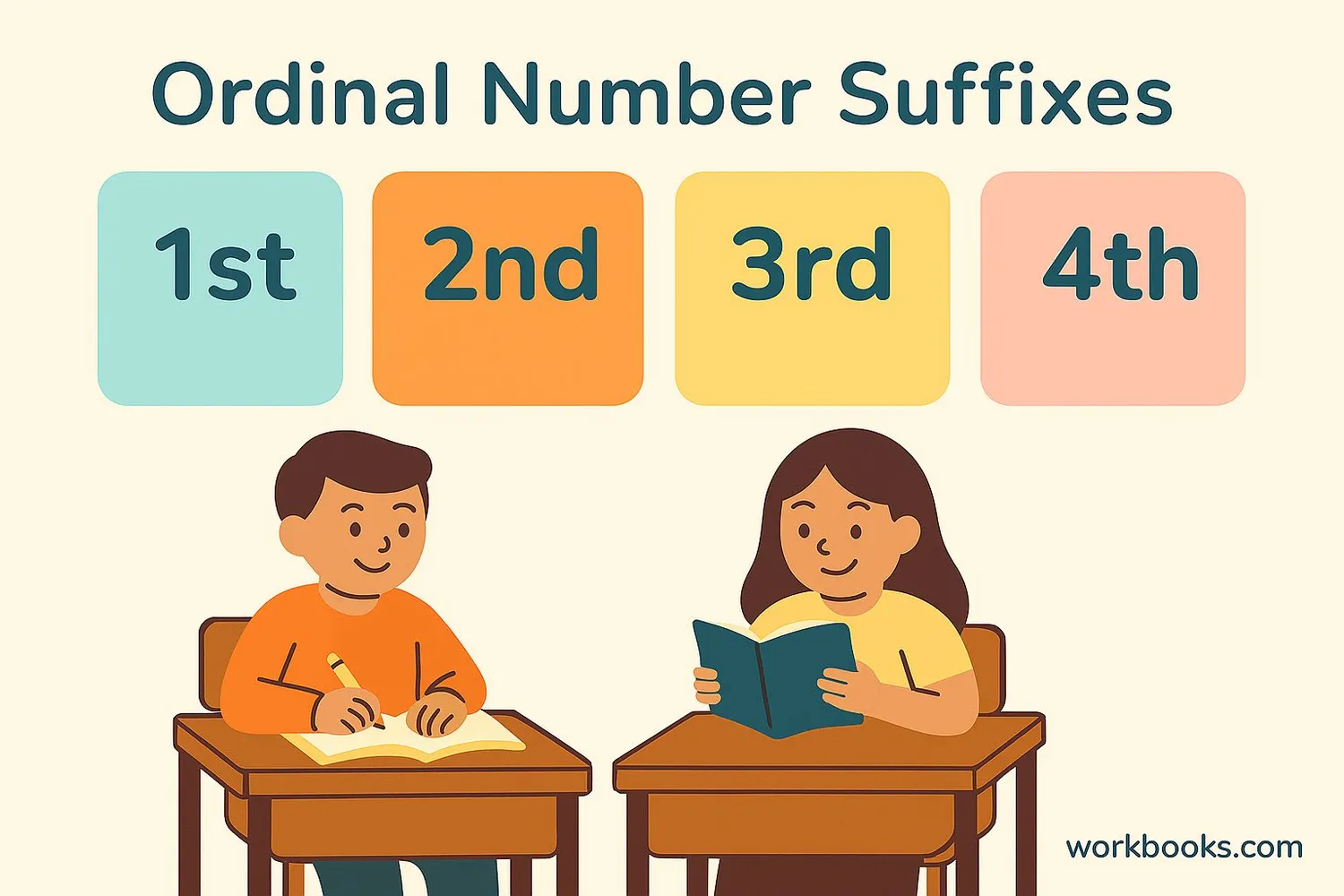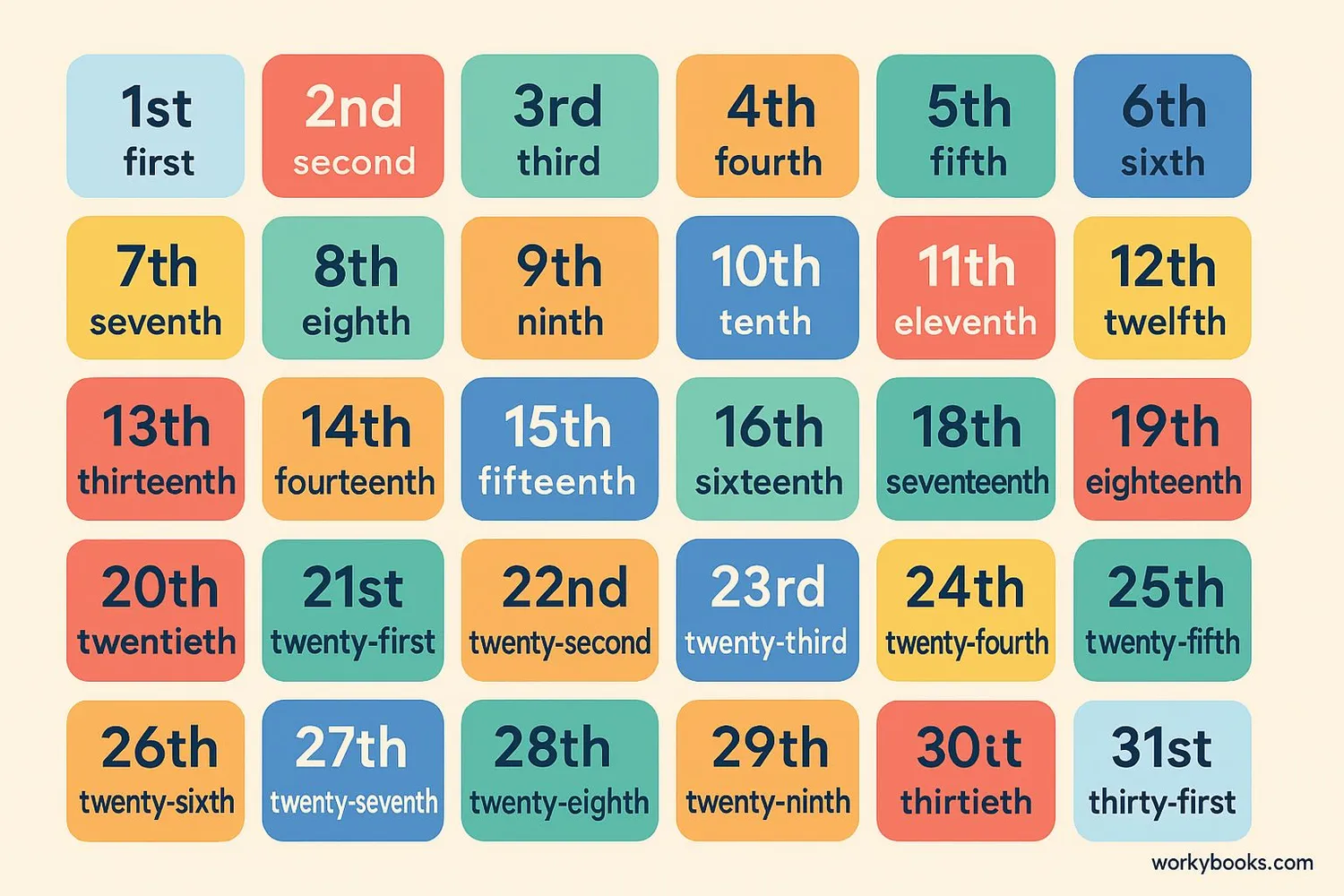Ordinal Numbers - Definition, Examples, Quiz, FAQ, Trivia
Learn about position and order numbers with clear explanations, examples, and practice activities
What Are Ordinal Numbers?

Ordinal numbers tell us about position or order in a sequence. While cardinal numbers (like 1, 2, 3) tell us "how many," ordinal numbers (like 1st, 2nd, 3rd) tell us "what position."
We use ordinal numbers every day for:
- Dates (July 4th, December 25th)
- Positions in a race (1st place, 2nd place)
- Floors in a building (3rd floor)
- Order in line (5th in queue)
- Birthdays (21st birthday)
The main ordinal numbers from 1 to 10 are: 1st (first), 2nd (second), 3rd (third), 4th (fourth), 5th (fifth), 6th (sixth), 7th (seventh), 8th (eighth), 9th (ninth), and 10th (tenth).
Key Concept
Ordinal numbers answer "Which one?" rather than "How many?" They show position or order in a sequence.
Writing Ordinal Numbers

Writing ordinal numbers correctly involves adding special endings to numbers. Here's how to do it:
Ordinal Number Rules
Most numbers use -th, but 1st, 2nd, and 3rd have special endings.
- Numbers ending with 1 (except 11) use -st (1st, 21st, 31st)
- Numbers ending with 2 (except 12) use -nd (2nd, 22nd, 32nd)
- Numbers ending with 3 (except 13) use -rd (3rd, 23rd, 33rd)
- All other numbers use -th (4th, 11th, 12th, 13th, 20th)
Step 1: Start with the number → 5
Step 2: Check the last digit → ends with 5
Step 3: Apply the rule → numbers ending with 5 use -th
Result: 5th (fifth)
Remember
The numbers 11, 12, and 13 are exceptions - they all use -th (11th, 12th, 13th) even though they end with 1, 2, and 3.
Ordinal Number Examples

Let's look at some real-world examples of ordinal numbers:
Example 1: Dates
"Her birthday is on June 10th." (Tenth)
"Independence Day is July 4th." (Fourth)
Example 2: Race Results
"Maria finished in 1st place, Jamal was 2nd, and Li was 3rd."
Example 3: Building Floors
"The library is on the 5th floor of the building."
Example 4: Birthdays
"Today is my 8th birthday!"
Example 5: Sequence in Line
"I'm 12th in the lunch line today."
Practice using ordinal numbers when talking about dates, positions, or order of events.
Practice Tip
Look for ordinal numbers around you - on calendars, in sports results, on building floors, or in book chapters.
Ordinal Numbers Chart

This chart shows ordinal numbers from 1st to 31st, which is especially helpful for understanding dates:
Ordinal Numbers 1-31
| Number | Ordinal | Word Form |
|---|---|---|
| 1 | 1st | First |
| 2 | 2nd | Second |
| 3 | 3rd | Third |
| 4 | 4th | Fourth |
| 5 | 5th | Fifth |
| 6 | 6th | Sixth |
| 7 | 7th | Seventh |
| 8 | 8th | Eighth |
| 9 | 9th | Ninth |
| 10 | 10th | Tenth |
| 11 | 11th | Eleventh |
| 12 | 12th | Twelfth |
| 13 | 13th | Thirteenth |
| 14 | 14th | Fourteenth |
| 15 | 15th | Fifteenth |
| 16 | 16th | Sixteenth |
| 17 | 17th | Seventeenth |
| 18 | 18th | Eighteenth |
| 19 | 19th | Nineteenth |
| 20 | 20th | Twentieth |
| 21 | 21st | Twenty-first |
| 22 | 22nd | Twenty-second |
| 23 | 23rd | Twenty-third |
| 24 | 24th | Twenty-fourth |
| 25 | 25th | Twenty-fifth |
| 26 | 26th | Twenty-sixth |
| 27 | 27th | Twenty-seventh |
| 28 | 28th | Twenty-eighth |
| 29 | 29th | Twenty-ninth |
| 30 | 30th | Thirtieth |
| 31 | 31st | Thirty-first |
Chart Tip
Notice how the pattern repeats every ten numbers, but with "twenty-" (or "thirty-", etc.) in front: 21st, 22nd, 23rd, 24th, etc.
Ordinal Numbers Quiz
Test your understanding with this 5-question quiz about ordinal numbers:
Frequently Asked Questions
Here are answers to common questions about ordinal numbers:
Number Trivia
Discover interesting facts about numbers and counting:
Ancient Number Systems
The ancient Romans used ordinal numbers in their calendar. That's why we still use Latin-based names like September (7th month), October (8th month), November (9th month), and December (10th month), even though they're now the 9th-12th months.
Around the World
Different languages have different rules for ordinal numbers. In Spanish, ordinal numbers are only commonly used up to 10th (décimo), then cardinal numbers are typically used for higher positions.
Math Connections
In mathematics, ordinal numbers extend beyond everyday counting to describe the order type of well-ordered sets, even infinite ones! This advanced concept was developed by Georg Cantor in the late 19th century.
Sports Records
The highest ordinal number commonly used in sports is probably "500th" in baseball, where players celebrate their 500th home run. Only 28 players in MLB history have reached this milestone.





